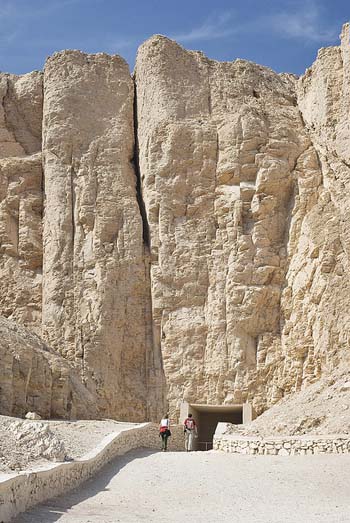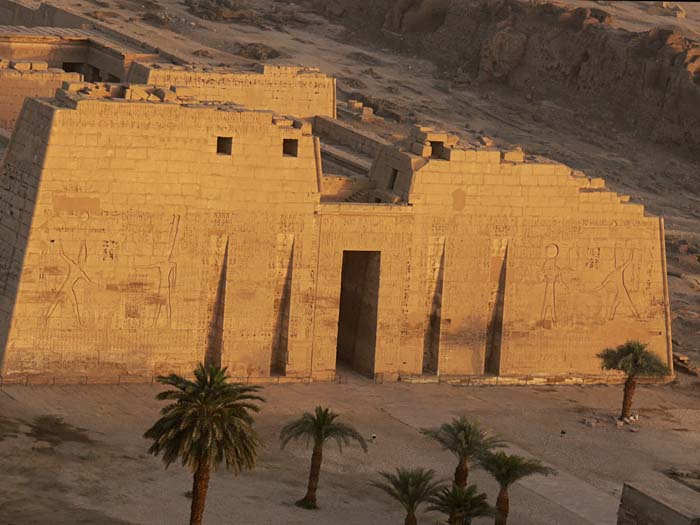Thebes
As the capital city of ancient Egypt during parts of the Middle Kingdom and New Kingdom, Thebes is home to many of the most magnificent monuments from the age of antiquity.
Two parts to Thebes existed: the Eastern bank of the Nile River, home to the main city, and the Western bank, which held the Necropolis, or City of the Dead. The majority of the population lived within the city on the Eastern bank, while people who served the king, like soldiers, laborers, craftsmen, priests, etc., lived on the Western bank.
Where Was Thebes?
Today, the area that Thebes occupied in ancient Egypt is now home to the city of Luxor. As part of Upper Egypt, Thebes sat about 500 miles south of the Mediterranean Sea, and about 450 miles south of Cairo on the Nile River. It covered an area of 36 square miles which included both sides of the Nile River.
History of Thebes
Egyptians started settling in the area of Thebes around 3200 B.C. Known to them as Waset, it eventually rose in importance to Egypt when royal families started lived there during the 11th dynasty. At that time, Thebes was called Nowe after Amun, its main god. It was also known as “The City of Amun”. The name “Thebes” came from the Greek name for the city, “Thebai”. During the rule of the pharaohs of the 9th and 10th dynasties, Thebes became the governmental power center of Egypt.
After the Theban nomarchs challenged the pharaohs and won, Thebes emerged as the capital city of Egypt in 2035 B.C. and remained the royal city until Akhenaton moved it to El-Armana. However, after Akhenaten’s death in 1334 B.C., Thebes was restored as Egypt’s capital city.
In 663 B.C., Thebes was plundered by Assyrians and never fully recovered enough to again be the thriving capital city it once was. However, since that time it has been a cherished Egyptian city for its mortuary temples and monuments. Thebes has always been a favorite among the pharaohs and many have lavished their wealth upon the city building shrines, public buildings, terraces and temples all in the name of Amun, one of the creation deities.

© Steve F-E-Cameron - View of the Theban Necropolis
Ancient Egyptian Temples and Religion in Thebes
Many monuments in Thebes still stand in good condition today and all were dedicated to Amun as he was the supreme God of Thebes. On the east side of the river in the main city of Thebes, the Karnak complex and the Luxor Temple were built and are popular tourist attractions today.
Karnak is the largest temple complex in Thebes. Construction on Karnak started during Senusret I's reign during the Middle Kingdom and lasted until the Ptolemaic Period. 30 different pharaohs contributed to its construction and at one time it was a main place of worship for ancient Egyptians.
Founded in the New Kingdom (around 1400 BC), the Luxor Temple was the site of one of the most significant religious festivals, the Opet Festival. The Luxor Temple is dedicated to Amun, Mut and Khonsu and during the Opet Festival the statues of these gods were transported from the temple complex at Karnak to the Luxor Temple.
Across the Nile River on the West side, the Valley of the Kings, or “City of the Dead” was where many pharaohs and other members of royalty were laid to rest, especially during the New Kingdom (1550 B.C. to 1070 B.C.).

© Shelby Root - Valley of the Kings
Many important kings were buried in the Valley of the Kings including:

© arch2452 - Tomb Entrance, Valley of the Kings
- Amenhotep II & III
- Seti I
- Merenptah
- Thutmose II, Thutmose III & IV
- Tutankhamun
- Ramses II
This area is also home to the Valley of the Queens, where 90 known queens, princes and others of high nobility were buried. Some of these included:
- Nefertari (Wife of Ramesses II)
- Imhotep (Vizier to Thutmose I)
- Mut (Wife of Seti I and Mother to Ramesses II)
- Sitre (Wife of Ramses I)
The Temple of Hatshepsut is also one of the most impressive structures in the Thebes area. Built into a cliff, the temple’s chapels are dedicated to Anubis and Hathor.
The Mortuary Temple of Amenhotep III has been mostly demolished, but what remains is an impressive 33 foot stele and two enormous statues that are known as the Colossi of Memnon.
The Temple of Seti I is still partially intact. Dedicated to Ramses I, it was completed by his grandson, Ramses II. The walls of the temple are covered with religious content.
The Ramesseum is the mortuary temple of Ramses II. The analyzing of fragments reveals that a huge statue of Ramses II, nearly 55 feet tall, stood at the entrance.
The Temple of Ramses III at Medinet Habu is the most Southern temple of the group. Very well preserved, this temple has elaborate battle and worship scenes carved on the walls.

© Walwyn - View of Medinet Habu
Archaeology in Thebes
In 1979, UNESCO (The United Nations Educational, Scientific and Cultural Organization) designated the entire Thebes area a World Heritage Site. This included the city of Luxor, Karnak, The Valley of the Queens and the Valley of the Kings. A World Heritage Site is defined as any site that has outstanding universal value in an effort to preserve global cultural treasures.
Recently, a Spanish-Italian archaeological team discovered an ancient reproduction of the Tomb of Osiris. The tomb is believed to date back to the 25th dynasty (760-656 BC). The tomb consists of a hall supported by five pillars and a nearly 30 foot long staircase shaft that attached chamber to chamber. The tomb has reliefs of demons holding knives which are meant to protect the dead.
Facts about Thebes
- The Greek Poet, Homer, wrote about Thebes’ wealth in The Iliad.
- Mentuhotep II (2061-2010 B.C.) stabilized the region and established Thebes as a thriving city.
- Known to the ancient Egyptians as “City of the Was” – a “was” was a long staff that had the head of an animal and a forked base.
- Thebes worshiped the Theban Triad which consisted of Amun, Mut and Khonsu.
- At the height of popularity and prosperity, Thebes had a population of 80,000.
- At one time, Amun was considered a lesser (more local) God, but was then merged with Ra and became a national God.
- At one time, the Luxor Temple and the Karnak Complex were linked with a nearly two mile long avenue that was flanked by sphinxes.
- King Tut’s tomb in The Valley of the Kings was discovered by Howard Carter in 1922. It was one of the most well-preserved tombs in the valley.
